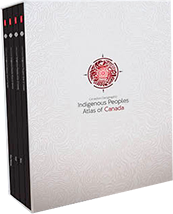Colonialism
Many, but certainly not all, of the traditions, values, skills and knowledge that bound us together as Inuit gave way in response to the demands placed on us from the outside. The whalers, the fur traders who followed the whalers, the missionaries and then the government all wanted something from us in return for what they were prepared to give. Slowly, we started to lose control over the destiny of our culture and our lives.
The whalers were the first outsiders to come into the North for economic reasons based on the harvest of our resources. The Thule Inuit exploited the large whales, but there is no evidence to show that this harvest was not sustainable. The explorers of Davis Strait and Hudson Bay brought back reports of huge pods of whales, and this provided an incentive for commercial whalers to enter the Arctic and Subarctic on the hunt for whales.
Beginning in the early 1700s, intensive whaling by Europeans would have a direct impact on the lives of Inuit living at that time. The whaling historian William Scoresby wrote in 1820 of the intensity of early whaling activities, noting that between 1719 and 1778, a total of 3,161 Dutch ships alone had carried out whaling activity in Davis Strait.
A single season could have as many as 35 ships in Davis Strait alone. In those times, the whalers would arrive as the ice broke up and leave when the new ice began to form. The only whalers who wintered in the Arctic were those who had their ships trapped or destroyed by pack ice.
After 1850, the patterns of whaling changed. Year-round shore stations were established in some areas like Cumberland Sound, creating a permanent presence of outsiders in the Arctic. It was the year-round presence of the whalers that brought about a new level of impact on trade, on the pattern of seasonal land use and, perhaps most significantly, on Inuit health. As year-round settlements brought increased contact with European whalers for the Inuit, the Inuit population began to significantly decline due to the introduction of disease brought into the Arctic by the whalers. The sicknesses that came to our Lands, such as tuberculosis, are still here today, and it has taken a terrible toll on our society over the years. But other “awful practices” took tolls of a different type.
Beginning in the early 1700s, intensive whaling by Europeans would have a direct impact on the lives of Inuit living at that time.
During the last half of the 1800s overharvesting of whales year after year by Europeans finally surpassed the limit of sustainability. The decline in the harvest made this activity no longer profitable for the commercial whalers, but it also meant that one of our important sources of food was endangered. This problem was made worse by the fact that towards the end of the whaling period, the whalers turned to other, smaller marine mammals such as beluga whales, walrus and even the larger seals.
At the same time, the market for whale oil and other products was declining. Some whaling captains and crews turned to trapping foxes. This marked the beginning of the fur-trading era. The whalers supplied our ancestors with steel traps and taught them to trap the fox and then trade the fur in order to get credit to obtain guns, ammunition and other goods. The transition to the fur economy occurred over a period of about 25 years, so the economy and culture of fox trapping did not fully develop much before the 1920s. Thus, the first two decades of the 20th century began a major transition in the type of economic adaptation that would define our Inuit way of life right into the 1990s.

The best strategy for fox trapping required small groups to spread out over a large region called a trapline. This tended to break apart our traditional social groups and to reduce the potential for cooperation that was so essential for our acquisition and sharing of food, skills and social responsibilities. In addition, the places where the trapping was good frequently did not coincide with our preferred areas to hunt and gather food. When we talk to Elders who remember these times, they explain how their decisions were taken over by the fur trader who controlled Inuit through his power to issue credit and to collect debts.
The need for goods or for repayment of debt, and what appears to be an apprehension to go against the wishes of the store manager, was responsible for hunters and their families establishing themselves in areas of good trapping, but perhaps poor hunting. Removing Inuit from their food sources further increased our reliance on trading posts to obtain food and resources.
The first missionaries entered the North along the Labrador coast when the Moravians established a mission station at Nain in 1771. The Moravian Church is still active in this region. For most other areas, however, active contact with missionaries did not begin for another 100 years. Missionaries expanded their influence in the east and other parts of the Arctic in the late 1800s. The missionaries had no direct ties with the government, except for their role in education and, in some locations, for medical services.
The North-West Mounted Police (which later became the RCMP) began to establish its own type of influence when it entered the eastern Arctic in the early 1900s. The mandates of the missions and police created different types of impacts on the Inuit who were living there at that time, one based on ideology and the other on law. The introduction of Christian teaching by the missionaries resulted in significant changes in the way in which we viewed and explained the world and new meanings that were assigned to living and dying.
Although the missionaries went north to bring the teachings of Christianity to Inuit, their presence was used by government for the purpose of providing rudimentary educational and health services. For the first half of the 20th century, all of the education provided in the North was carried out in missionary schools. The relation between missions and the health services was even more direct.
We often hear non-Inuit talk about how missionaries were not good for us. When Inuit talk about this, they usually give another opinion and tell of their respect for the religious teachings, and for the other roles they played — especially in those early days. Some have recently turned to more fundamental religions, while other individuals continue to stay with the churches of their childhood. One way or another, these teachings have become part of our life and culture.
The services of the North-West Mounted Police began with concerns about “law and order” in the North, the protection of northern biological resources and the question of territorial sovereignty. The first posts were created in 1903 in the western Arctic with the mandate to demonstrate Canada’s sovereignty throughout the region. A few years later, posts were established in the eastern Arctic. The location of these posts had certain strategic significance since they controlled access to the Arctic lands and waters.
In those days, there was little understanding about our culture. It was simply up to the trader, missionaries and police to look after our lives and always on their terms, not ours.

Order now
from Amazon.ca or Chapters.Indigo.ca or contact your favourite bookseller or educational wholesaler




